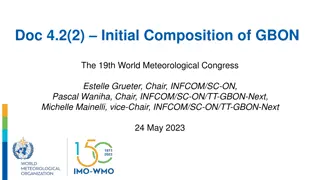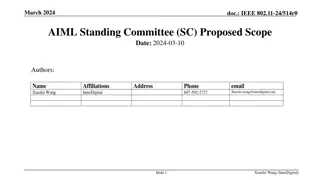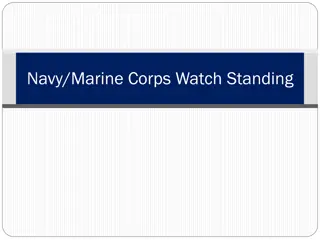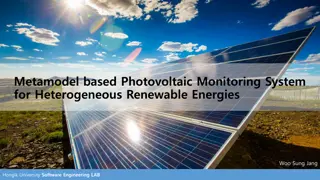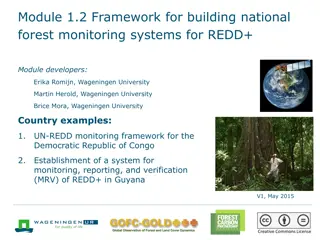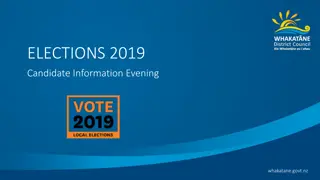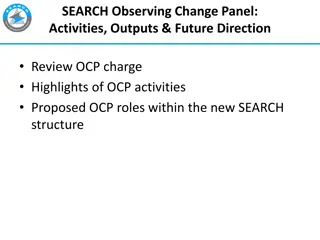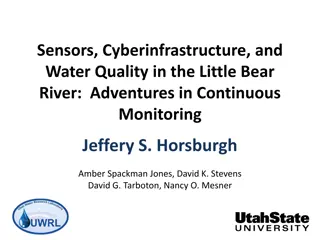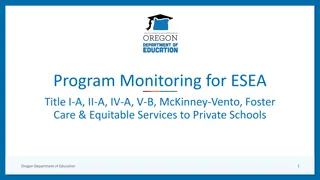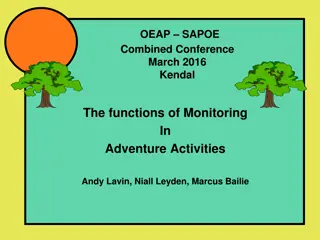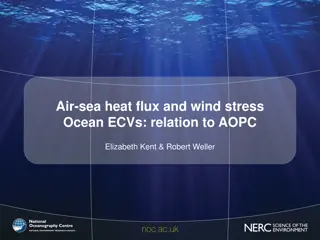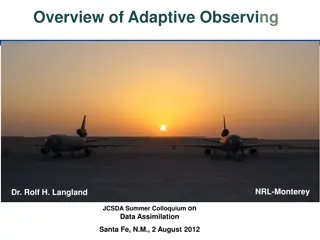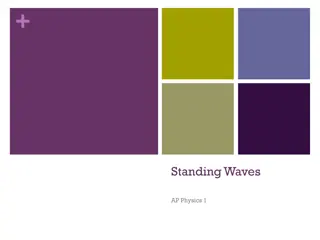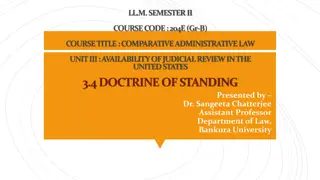Standing Committee on Earth Observing Systems and Monitoring Networks
The Standing Committee on Earth Observing Systems and Monitoring Networks focuses on optimizing the acquisition of Earth system observation data through the WMO Integrated Global Observing System, in line with WMO's Strategic Plan objective. It develops guidance and tools to enhance network design and monitoring performance.
Download Presentation

Please find below an Image/Link to download the presentation.
The content on the website is provided AS IS for your information and personal use only. It may not be sold, licensed, or shared on other websites without obtaining consent from the author.If you encounter any issues during the download, it is possible that the publisher has removed the file from their server.
You are allowed to download the files provided on this website for personal or commercial use, subject to the condition that they are used lawfully. All files are the property of their respective owners.
The content on the website is provided AS IS for your information and personal use only. It may not be sold, licensed, or shared on other websites without obtaining consent from the author.
E N D
Presentation Transcript
Second Session of the Infrastructure Commission (INFCOM-2, 24-28 October 2022) Item 6.1 Standing Committee on Earth Observing Systems and Monitoring Networks (SC-ON) (Estelle Grueter, Chair, SC-ON) 1
Standing Committee on Earth Observing Systems and Monitoring Networks (SC-ON) Chair: Vice-Chair: Estelle Grueter (Switzerland) Sid Thurston (USA) Per its Terms of Reference, responds to WMO Convention Article 2(a) on WMO s primary purpose to facilitate worldwide cooperation in the establishment of networks of stations for the making of meteorological observations as well as hydrological and other geophysical observations related to meteorology SC-ON provides focus on the normative work and technical systems including the development of guidance and tools required to achieve Objective 2.1 of the WMO Strategic Plan: {to} Optimize the acquisition of Earth system observation data through the WMO Integrated Global Observing System (WIGOS) , with a focus on improving network design through a tiered approach and monitoring performance, and where appropriate taking into consideration existing Quality Management Framework guidance .
Documents submitted to INFCOM-2 Doc Decision/Recommendation Doc Decision/Recommendation 6.1(1) Draft Rec. on High Level Guidance on the Evolution of Global Observing Systems in Response to WIGOS Vison 2040 6.1(8) Draft Rec. on the WMO Position Paper on Radio Frequencies 6.1(3) Draft Rec. on the update of WIGOS Manual (WMO-No. 1160) 6.1(9) Draft Rec. on the initial composition of GBON 6.1(4) Draft Rec. on the update of Update of WIGOS Guide (WMO-No. 1165) 6.1(10) Draft Rec. on the VLab Strategy (2024-2027) 6.1(5) Draft Rec. on the update of Guide to ABO (WMO-No. 1200) 6.1(11) Draft Rec. on Improving Climate Observations in relation to GCOS Implementation Plan 6.1(6) Draft Decision on the process to nominate and implement a Pilot GSRN 6.1(12) Draft Rec. on the Guide to the Global Basic Observing System (GBON) 6.1(7) Draft Decision on the recognition of the concept for tiered Networks concept
INF documents submitted to INFCOM-2 INF 25 Title High Level Guidance on the Evolution of Global Observing Systems in Response to WIGOS Vison 2040 Data Exchange Requirements of Core Satellite Data 6.1(2) 6.1(3) Update RRR Process per WMO s Earth System Approach 6.1(5) Updated WICAP Implementation Plan 6.1(11.1) 2022 GCOS Implementation Plan 6.1(11.2) 2022 GCOS ECV Requirements
Doc 6.1(1) High Level Guidance (HLG) on the Evolution of Global Observing Systems in Response to WIGOS Vison 2040 Draft Recommendation to Congress Annex includes Executive Summary of HLG document Complete document provided in INF 6.1(1) See Erik Andersson s (Chair JET-EOSDE) presentation later during the Session
Doc 6.1(3) Update of WIGOS Manual (WMO-No. 1160) Draft Recommendation to the Executive Council New provisions in 1.3.1 on the Regional WIGOS Centres Clarifications on RBON requirements in 3.2.3 Update of Attachment 2.2 on the WIGOS Station Identifiers Addition of WHOS and ABO Metadata as recognized entities for Issuers of Identifiers Substantial update of the Rolling Review of Requirements chapter in Appendix 2.3 see INF 6.1(3) for full description) Taking into account WMO s Earth System approach Introducing 6 Earth System Application Categories (1 statement of guidance for each) Introducing priorities of observational user requirements New Appendix 3.1 on the designation process of GBON stations
Doc 6.1(4) Update of WIGOS Guide (WMO-No. 1165) Draft Recommendation to the Executive Council Chapter 2, WIGOS Station Identifiers: New issuer of identifiers for ABOMetadata Repository and WHOS Chapter 3, WIGOS Metadata: Addition of section 3.2.3 on Guidance material related to grouping observing facilities to station clusters Chapter 5, Observing Network Design: Consistency with the new RRR process, in particular concerning the OND Principles Chapters 6 and 7, Guidance on National WIGOS Implementation and WIGOS Data Partnership: Update in relation to the implementation of the WMO Unified Data Policy and GBON Technical Regulations
Doc 6.1(4) Update of WIGOS Guide (WMO-No. 1165) Chapter 8, Establishing and operating a RWC: Chapter renamed & updated to replace the former chapter on Establishing RWCs in pilot mode Chapter 9, WDQMS: Added guidance on the WDQMS webtool Chapter 10, Attributes specific to WIGOS component obs. systems: New sub-sections on issuing WIGOS Station Identifiers for WHOS and Copernicus C3S Chapter 11 (new chapter): RBON design process at the regional level
Doc 6.1(5) Update of Guide to ABO (WMO-No. 1200) Recommendation to the Executive Council Comprehensive review of the Guide by JET-ABO, including: Latest developments with ABO program in particular reflecting the establishment of WICAP with IATA Reflects current practices associated with management of aircraft-based observing systems and observational data and metadata To ensure consistency, chapter on ABO in WMO-No. 8 has also been reviewed and updated
Doc 6.1(6) Process to nominate and implement a Pilot GSRN Draft Decision 6.1(6)/1 1. To endorse the implementation plan for a Pilot GCOS Surface Reference Network Pilot 2. To request SG to call for Members to nominate stations for the pilot GSRN 3. To urge Members to consider nominating stations with reference measurements to be part of the pilot GSRN 4. To request GSRN Lead Centre & GCOS Secretariat in consultation with TT- GSRN to manage the process Annex to draft Decision includes proposal on the implementation and station nomination process for a pilot GSRN and the requirements for the pilot GSRN stations
Doc 6.1(7) Recognition of the concept for Tiered Networks concept Draft Decision 6.1(7)/1 To endorse the concept for Tiered Networks Annex includes proposal for formalization and standardization of tiered network approach across domains and observing system programmes To request P/INFCOM to consider establishment of a mechanism for Criteria to assign candidate networks to tiers, linking to WDQMS, Siting Classification, Measurement Quality Classification scheme Governance of the process, sustainable for INFCOM & Members Implementation Plan for tiered networks across domains Reporting progress to INFCOM-3
Doc 6.1(8) WMO Position Paper on the World Radiocommunication Conference 2023 (WRC-23) Agenda Recommendation to the Executive Council To endorse the preliminary position paper (in annex) To delegate authority to P/WMO to recommend to Congress the final WMO Position on WRC-23 Agenda (finalized based on outcome of WRC s Preparation meeting)
Doc 6.1(9) Initial composition of GBON Doc 6.1(12) Guide to the Global Basic Observing System (GBON) Recommended by the Task Team on GBON Implementation See presentation by Pascal Waniha (TT-GBON Chair) later during this Session
Doc 6.1(10) VLab Strategy (2024-2027) Recommendation to the Executive Council: to adopt the updated VLab Strategy for 2024 2027 replacing the VLab Strategy 2020 2024, aligning the cycle of the VLab Strategy with the four-year WMO financial period (in annex); to request the President of INFCOM to finalize the VLab Strategy for 2024 2027 to be aligned with the Capacity Development Strategy The new strategy takes into account new areas and challenges: the goal declared by the UN Secretary-General : "Within the next five years, everyone on Earth should be protected by early warning systems against increasingly extreme weather and climate change" the need to address societal challenges and global development agendas put forth under the 2030 Agenda for Sustainable Development, the Sendai Framework for Disaster Risk Reduction 2015-2030, and the Paris Climate Agreement Following the direction from the CGMS-50 Plenary, the new strategy: places high emphasis on building capacity among WMO Members for understanding and exploiting data from the new- generation satellites, instruments, data and product dissemination systems, and processing hardware and software Following the direction from WMO, the new strategy: strives to follow a more integrated Earth system approach, establishing interdisciplinary connections to ensure data interoperability and knowledge sharing for satellite-based application areas linking meteorology, climatology, hydrology, agrometeorology, oceanography, atmospheric composition, geology, and many other fields The document has been discussed with the WMO Expert Team on Space Systems and Utilizations and the Coordination Group for Meteorological Satellites (CGMS) and is anticipated to be endorsed by CGMS-51 Plenary in June 2023.
Doc 6.1(11) Improving Climate Observations in relation to GCOS Implementation Plan Recommendation to the Executive Council to endorse the conclusions of the 2022 GCOS Implementation Plan (GCOS-244) and the 2022 GCOS ECVs Requirements (GCOS-245) to request the president of INFCOM to take into account the findings of GCOS in its workplan to recommend (via Executive Council) the WMO Congress to urge members to take action to address the 2022 GCOS Implementation Plan actions relevant to NMHS Annex includes the complete list of actions for which WMO and NMHS have been identified as primary implementers
Thank you 16
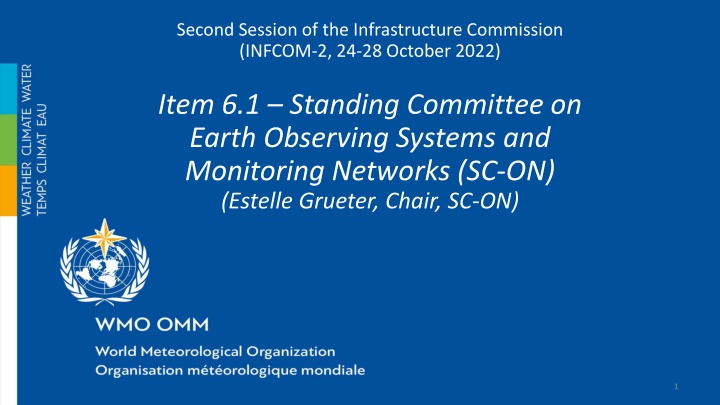

![[PDF⚡READ❤ONLINE] Solar Surveyors: Observing the Sun from Space (Springer Praxis](/thumb/21536/pdf-read-online-solar-surveyors-observing-the-sun-from-space-springer-praxis.jpg)
